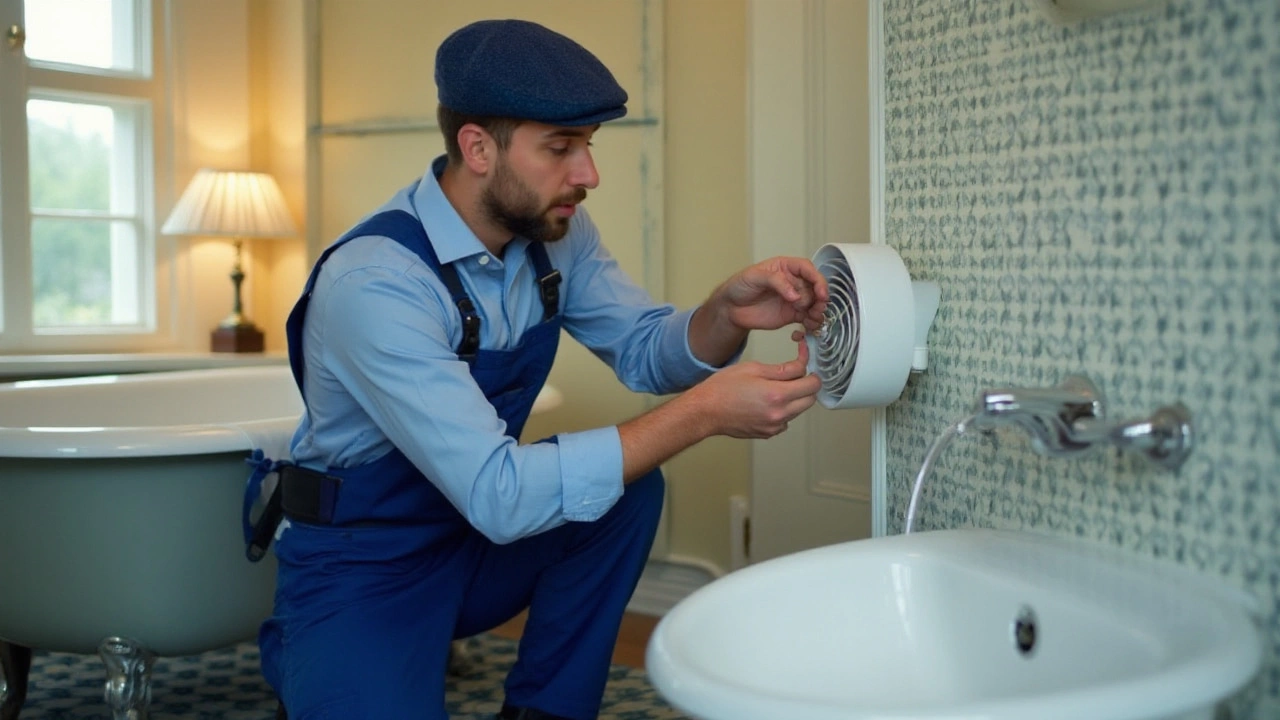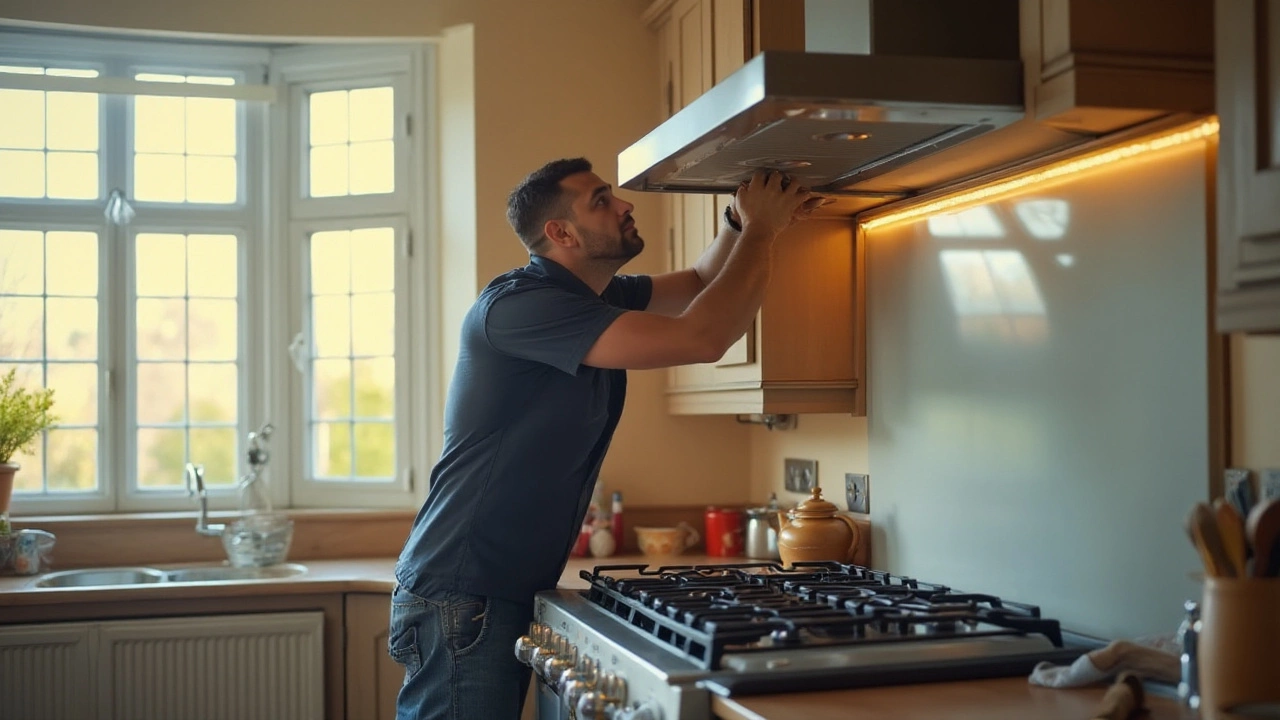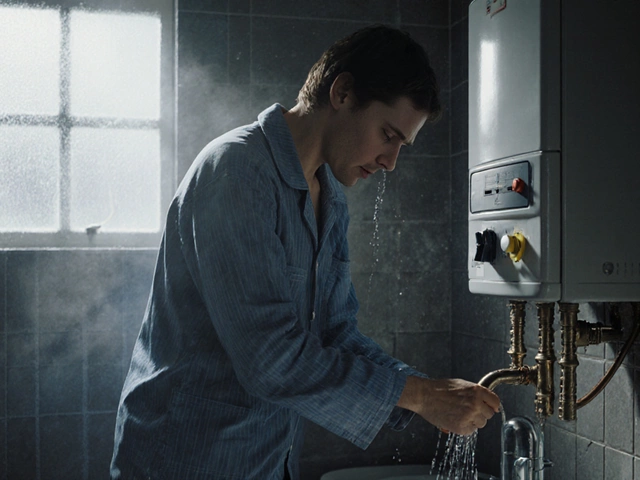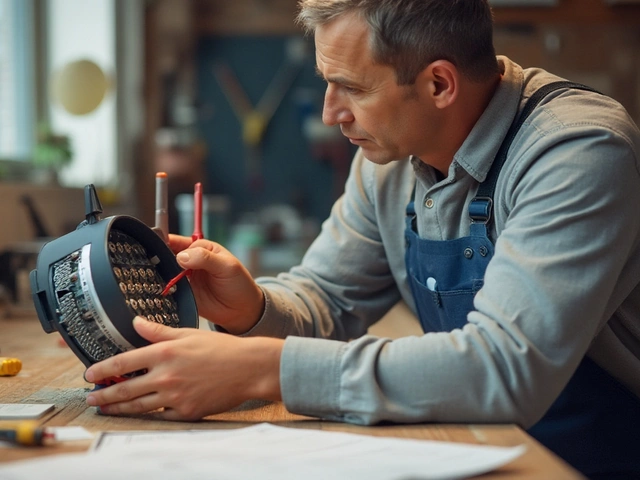Extractor fans are a staple in modern homes, essential for maintaining a healthy environment by removing unwanted moisture and odors. But when it comes to fitting one, who do you call—a plumber or an electrician? It can be a bit of a head-scratcher.
Understanding who to hire depends on the specific needs of your fan installation and a few other considerations. Here's a rundown to help demystify the process and guide you in making the best decision for your home.
- Understanding Extractor Fans
- Choosing the Right Tradesperson
- Electricians and Their Role
- Plumbers' Expertise
- DIY Considerations and When to Call a Pro
- Tips for Successful Installation
Understanding Extractor Fans
An extractor fan is a mechanical fan used primarily to draw out moisture and odors from homes, especially in areas prone to dampness such as the kitchen and bathroom. These fans play a crucial role in maintaining indoor air quality and overall home health by expelling unwanted humidity, smoke, and unpleasant scents. When installed correctly, they help prevent the buildup of mold and mildew by maintaining proper ventilation and airflow. Some might say extractor fans are unsung heroes in keeping our homes not just pleasant but structurally sound.
Extractor fans come in various types, including wall-mounted units, window fit models, and ceiling installations, each suited for particular spaces and needs. The most common ones in domestic settings are axial fans, which are ideal for smaller rooms like bathrooms, while centrifugal fans are more suited for areas with longer ducting runs, such as kitchens. Their operation principle relies on creating a low-pressure zone to draw air from a room, pushing it outside through an external vent. The importance of selecting the right type cannot be overstated for achieving efficiency in air extraction and energy consumption.
When considering fitting an extractor fan, understanding the noise level, measured in decibels, is important for comfort in living spaces. Models with noise levels below 30 decibels are typically considered quiet, while those over 50 may interfere with day-to-day activities, especially in communal living areas. Energy efficiency, measured in watts, is another crucial factor, as eco-friendly designs save both energy costs and help reduce your carbon footprint. Advanced models even integrate features like humidity sensors and timers, automating much of the operation process.
"The right ventilation system preserves the structural integrity of homes, preventing decay and sometimes very costly repairs," remarked Lisa Eckstrom, a well-known home improvement author.
Moreover, extractor fans help comply with building regulations aimed at ensuring adequate airflow and the safe venting of fumes in domestic environments. Failing to meet these standards can not only result in fines but also pose health risks, reinforcing the need to choose a suitable fan model and engage a competent tradesperson for installation. Understanding these elements of extractor fans underlines their importance in everyday life and the necessity of making informed decisions when it comes to installing or upgrading them in your home.
Choosing the Right Tradesperson
When it comes to installing an extractor fan, selecting the right professional can make all the difference. Not only will they ensure that the job is done safely and efficiently, but they will also advise on the best model and placement for optimal performance. Typically, you have two primary options: electricians and plumbers. Both trades have unique skills, yet the choice largely depends on the specific demands of your installation. For instance, if your task involves complex electrical wiring, an electrician would be your go-to professional. Meanwhile, if you're working on a bathroom where plumbing is prominent, a plumber might be a better fit. This might seem obvious, but many homeowners are unsure about the scope and extent of each tradesperson's expertise.
Electricians are often the best choice for installations that require new wiring. They bring a wealth of knowledge concerning the electrical codes and safety standards that need to be adhered to, especially in wet areas like bathrooms and kitchens. On the other hand, if your installation concerns venting an extractor fan to an external wall, a plumber could provide valuable insight as they work regularly in such environments, ensuring seamless ductwork. Still, distinguishing between the roles can be complex since modern bathrooms and kitchens increasingly integrate plumbing and electrical elements.
Interestingly, some professionals have begun to specialize in installing extractor fans, offering a blend of skills. These individuals are aware of both the electrical and mechanical requirements for fitting the fans correctly. Hiring such a versatile tradesperson can be cost-effective as they handle all aspects of the installation without needing to call in backup—or you might even consider a general contractor. Trust is vital, and a recommendation from a friend or a family member is priceless. As Justin Falk, a renowned home improvement expert, said,
The right tradesperson doesn't just install a device; they enhance your living space, offering both practical solutions and aesthetic improvements.Taking a moment to read online reviews also helps a lot, giving you insight into the experiences of previous customers.
As you deliberate who to hire, keep in mind that the cost often varies depending on the technicality of the install. Electricians might have higher hourly rates compared to plumbers, yet they may complete the job more quickly, balancing out the costs. Be sure to get multiple quotes and compare not just costs, but also the expertise and reliability of the service providers. You might also want to inquire if they have any partnerships with fan manufacturers for warranty purposes. This way, you could leverage a longer-lasting guarantee while ensuring your new extractor fan performs efficiently.

Electricians and Their Role
When it comes to installing an extractor fan, electricians are often the go-to professionals. Their expertise in handling electrical systems is crucial since most extractor fans need a reliable power source and precise wiring. An electrician ensures that your fan is installed safely and complies with the local building codes. This is important for not only the functioning of the fan but also for your peace of mind, knowing that the installation won't pose any electrical hazards.
One of the key aspects an electrician focuses on is the wiring of the extractor fan. They have the skills to connect the fan to an existing electrical circuit or create a new one if necessary. This might include installing a dedicated switch or integrating the fan with the lighting circuit, allowing it to turn on automatically with the room's lights. This integration is often sought after in bathrooms and kitchens, where fans help control moisture and improve air quality.
Another critical role of electricians is assessing the load capacity of your current electrical system. Overloading a circuit can lead to frequent tripping of breakers, or worse, electrical fires. Electricians are trained to calculate the load and make sure the new fan will not push your system over its limits. They also test the fan installation to ensure it's running properly without any electrical hiccups.
"Safety is paramount," says John Cooper, a noted electrician with over two decades of experience. "An electrical fault can have dire consequences, which is why engaging a trained electrician is not just recommended, it's essential."
Besides their technical skills, electricians also offer valuable advice on choosing the right fan for your space, considering factors like extraction rate and noise level. This guidance is crucial, especially if there's uncertainty about which fan model would best suit your needs.
Common Steps in Electrical Installation
To give you an idea of what an electrician does during an installation, here’s a simplified step-by-step process:- Conduct an initial assessment of the installation site and existing electrical connections.
- Determine if the current circuits can accommodate the new fan or if a new circuit is necessary.
- Perform the necessary electrical work to either modify existing systems or install new ones safely.
- Mount the fan securely, following the manufacturer's specifications to ensure optimum performance.
- Test the fan's operation to ensure it functions correctly and safely post-installation.
The role of electricians in the fitting of extractor fans is undeniably significant. Their extensive training allows them to handle the complexities of electrical installations efficiently, ensuring your home remains a safe and functional space.
Plumbers' Expertise
When we think of plumbers, the immediate thought often drifts towards leaky pipes and clogged drains. However, their skill set extends much further, particularly in relation to the installation of extractor fans. The role of a plumber can sometimes crossover with that of an electrician, especially in spaces like bathrooms and kitchens, where the interplay between water and wiring is frequent. A plumber's understanding of ventilation solutions is crucial, especially when you consider that bathrooms are primary spots for extractor fan installation. These spaces can become damp and stuffy quickly, and a plumber is well-versed in ensuring that any setup provides effective moisture control.
Plumbers are often involved in scenarios where the extractor fan must be connected to existing ductwork. They can navigate through the complexities of a home’s layout to effectively manage air circulation, a task that involves not just the fan but the complete venting system. In homes where the duct paths are antiquated or convoluted, plumbers possess the knowledge and tools to reroute or extend these paths for optimum ventilation. Their role becomes indispensable when integrating a new fan into an older system that wasn't originally tailored to support modern ventilation needs.
Plumbers might also offer installing extractor fans as part of their suite of services. Their expertise ensures that the installed system adheres to building regulations and efficiently extracts air, ticking both state compliance and functionality boxes. Given that each state might have varied regulations on venting hot, steamy air outside efficiently, they'd know the nuances and ensure safety legislation is met, mitigating risks of mold growth due to inadequately vented moisture.
"Proper mechanical ventilation, such as that from an extractor fan, helps mitigate respiratory problems by reducing pollution within indoor environments," claims the American Lung Association.
When hiring a plumber for your extractor fan installation, it is important to ask what kind of similar projects they have handled before. Most reliable professionals will have a portfolio, or at least references, showcasing installations they've completed in the past. They’d also usually give an estimate after thoroughly appraising your space, offering insights into any potential challenges before work commences. Such forethought can save homeowners a lot of time and unpredictably expensive adjustments down the road.

DIY Considerations and When to Call a Pro
Tackling a extractor fan installation on your own can certainly be tempting, especially if you enjoy dabbling in home improvements. The thought of rolling up your sleeves and getting hands-on can offer a certain satisfaction, but there are important factors to consider. First and foremost, it's crucial to assess your comfort and skill level with electrical systems. If you have a knack for following complex instructions and unearthing solutions, this project might just be within your reach.
When weighing DIY options, think about specialized tools. Access to the right equipment can make a world of difference in maintaining safety and precision. But herein lies the rub – without these tools, an attempt to save money and time can quickly spiral into a costly affair. If you're missing something crucial, it often makes sense to pause and consider whether hiring someone who already possesses the necessary know-how and gear is a smarter move.
“The more you know, the more you realize you don't know. The less you know, the more you think you know.” – David Tennebaum, an expert in home installations.
Read up on local building codes and regulations if you're still game for the DIY approach. Even seemingly straightforward jobs can be subject to rules that may not be immediately clear. Tackling a project without compliance could cause issues down the road, such as problems with home insurance or legal penalties if something goes awry.
Now, when might it be best to call on a electrician or plumber? If your space has unique challenges, like old wiring or hard-to-reach ductwork, a professional’s experience could be invaluable. Experts are adept at navigating tricky installations and ensuring everything is not just set up, but functioning safely and effectively. They bring a wealth of knowledge on issues that could trip up an amateur, ensuring the job is done right the first time, saving you the headache of future repairs.
Consider time commitments, too. A professional can streamline the process, completing the installation swiftly and efficiently, whereas a DIY attempt could stretch over several days, especially if unforeseen challenges arise. For those balancing busy work and family schedules, this can be a pivotal factor in deciding.
When a Pro is a Must
Unfortunately, not every situation leaves room for DIY experimentation. If your new extractor fan involves modifying existing wiring or plumbing, it's not just recommended, but often necessary to bring in a licensed tradesperson for extractor fan installations. Many regions have strict codes regarding electrical and plumbing work, and only certified professionals have the expertise to comply.
Ultimately, the decision boils down to weighing your confidence against potential costs and complications. Should you attempt a DIY installation, be meticulous in your preparatory research, adhere strictly to safety protocols, and never hesitate to switch tactics if you find yourself in over your head. Extractor fans do more than just whisk away unwanted air; they are a vital part of your home’s safety and comfort. Ensuring they are installed competently won't just improve your home's functionality—it'll give you peace of mind.
Tips for Successful Installation
Installing an extractor fan may sound daunting, but with the right approach, it can be a straightforward task. Firstly, determining the ideal location is crucial. Aim for a spot where the fan can most effectively expel the air outside, avoiding long duct paths as they can hinder performance and efficiency. Consider any potential obstructions outside the building that could block the vent, such as bushes or fences, and check for any pre-existing wiring or pipework inside the wall that might complicate installation. Being meticulous at this stage can save significant time and avoid unnecessary complications later on.
Understanding your household's specific ventilation needs can significantly influence the choice of an extractor fan. For instance, high-humidity environments like bathrooms and kitchens might require a more powerful unit compared to a bedroom. Keep in mind that regulations specify certain extraction rates, typically measured in litres per second, that must be met according to the room's function. It’s worthwhile checking these standards, as they can guide your purchase and ensure the fan you choose is fit for purpose. A poorly sized fan could either underperform or be unnecessarily loud and energy-inefficient. The key takeaway is to align the fan’s capacity with the requirements of the space.
Ensuring a safe and compliant installation means addressing the wiring. It might seem like a DIY enthusiast's playground, but tampering with electrics without adequate knowledge can be risky. When an extractor fan requires electrical work, an electrician’s expertise is invaluable. Typically, these devices are powered through the lighting circuit to allow operation via the light switch, although they could also have a separate control switch. An electrician can ensure connections comply with local electrical codes, mitigating any potential hazards. They say, "Electricity is really just organized lightning," so you'll want someone trained in it to handle your fan’s wiring.
If your home relies on existing ductwork, ensuring it's in good condition is vital. Ducting should be clean and sealed at the joints to prevent air leakage, which can diminish the fan’s effectiveness. Pay particular attention to the duct length within the building, as longer routes can reduce airflow efficiency. Double-checking these factors means your fan will likely perform better, offering improved ventilation and energy usage. In some cases, a fan installation might be a good opportunity to upgrade older ducts to more modern and efficient materials.
When it comes to aesthetics, don't overlook the fan’s design. Modern extractor fans come in various styles, some resembling minimalist art, which can complement and enhance your room’s overall look. Remember, though, it’s not only about appearance; the fan must also maintain its primary function of air extraction. Manufacturers often provide decibel ratings for their fans, so those sensitive to noise might want to weigh fan style against sound levels. It’s a trade-off that can make day-to-day life much more pleasant when done right.
Lastly, to ensure a hassle-free installation, consider hiring a professional. While DIY can be rewarding, a seasoned tradesperson offers peace of mind and can quickly troubleshoot unexpected issues. They bring both the know-how and equipment to deliver a clean, efficient job. It's an investment in both your home’s integrity and your comfort. In this instance, perhaps it's best to heed the words of an old saying: "The bitterness of poor quality remains long after the sweetness of low price is forgotten."







